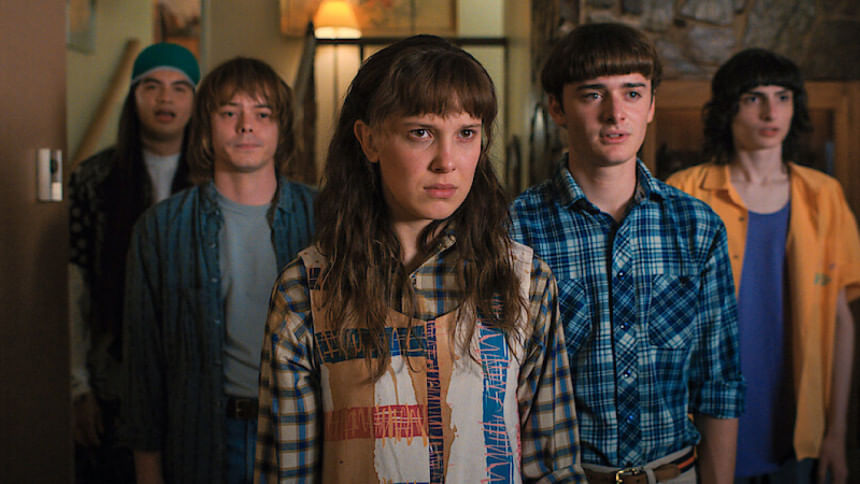Understanding ‘cliffhanger economy’: Why OTT platforms split seasons

Every time I settle in for a binge-watch, armed with snacks and the delusional belief that I have "just one more episode" worth of self-control, an OTT platform finds a new way to personally offend me by splitting a season into two. You open Netflix or Prime Video, click on a highly anticipated series, and halfway through, realise you are too early for the binge-watch. "Stranger Things" did it. "The Witcher" did it. "Bridgerton" and "Squid Game" Season 3 did it—and, more recently, the second season of "Wednesday" just did the very same. And don't even get me started on the "Money Heist" final-season split, which had the entire internet in a chokehold for weeks.
The initial frustration is understandable because we were sold the promise that streaming was the antidote to traditional TV's week-to-week cycle of agonised waiting. The OTT revolution was all about immediate gratification, with entire seasons dropping at once so we could finish a show over the weekend and then spend the week dissecting every detail online. But now, just a decade into that golden age, the platforms are reversing the deal. At first glance, this trend feels like an irritating interruption to the very viewing style that made OTT platforms popular in the first place. Why, then, are we suddenly being asked to pause?

The answer, unsurprisingly, lies in marketing and engagement because splitting seasons keeps people subscribed longer. If "Bridgerton" Part 1 drops in June and Part 2 in July, that is two months of guaranteed revenue instead of one. The model resembles the cliffhanger-heavy days of network TV, but here it is less about pacing the story and more about pacing the subscription cycle. Industry insiders admit it is partly a retention tactic, especially in a market where viewers cancel subscriptions the minute they finish the show they came for. However, after digging deeper and watching audience behaviour online, it is clear there is another layer to the experiment — OTT platforms are testing whether splitting a series can generate longer-lasting cultural relevance.
The issue with the binge model is the weekend drop-off. A show like "Squid Game" explodes globally upon release, dominates memes for about 10 days, and then vanishes from the conversation. With a two-part release, the hype is stretched. "Bridgerton 3" Part 1 had the internet swooning over Penelope and Colin, and just as the conversation started fading, Part 2 swooped in to revive it. That's essentially double the social media engagement, double the press coverage, and double the opportunity for influencers to make reaction videos.

This isn't entirely new—film franchises have been doing it for years. "Harry Potter and the Deathly Hallows" was split into two films; the final instalments in the "Twilight" and "The Hunger Games" film series were also produced in two parts, and Marvel now stretches a single story arc into two massive movie events to milk anticipation. The difference is that films feel like an event you wait for, while TV series were meant to be the comfort food you devour. So when something like "Stranger Things 4" splits itself in half, it creates a strange dissonance. We're still binging, but now with a mandatory intermission.
The other argument OTT executives make is creative: certain stories, they claim, benefit from a breather, giving viewers time to process big twists before diving into the resolution. And in some cases, that's true. "The Crown" Season 6, for instance, released its first half in November 2023 and the second in December. The opening episodes dealt with Diana's tragic death—a heavy, emotional arc that perhaps did deserve a pause before shifting to lighter plotlines. Similarly, Netflix marketed "You" Season 4's split as a way for audiences to play detective between parts, engaging in theories and speculation. But while some stories might genuinely gain from a split, many others feel chopped up for business reasons, leaving their pacing to suffer. The first half often plays like a slow burn with no real payoff, while the second half rushes to tie everything up. In a way, the strategy mimics old-school network television, where audiences waited a week between episodes and months between seasons—except now, the pause is artificially inserted into a season designed to be consumed as one.

What's more interesting is how this tactic is evolving into a hybrid between the binge and weekly models. Disney+ has stuck to weekly releases for Marvel and Star Wars shows, keeping fans hooked for months. Netflix—once the champion of the binge—is now dipping its toes into both worlds: Part 1 gives you enough episodes to satisfy a binge, but the gap forces you into old-school anticipation. Amazon Prime has tried variations, releasing a few episodes at once and then running the rest weekly. It's as if every major OTT platform is running experiments on our viewing habits to see how far they can stretch our patience before we riot. And patience is the currency here. Audience backlash is real, with many viewers claiming they would rather wait until a series is all out before watching. But streaming services are betting that FOMO will win. They know we'll watch Part 1 because we don't want to be spoiled online, and by the time Part 2 arrives, we'll be back—if only to continue being in the know before people, at large, get done with it.

If there's a silver lining to any of this, it's that some splits have created genuine "water cooler moments" online again. I remember when "Stranger Things 4" Part 1 ended with that mind-bending Vecna reveal—the internet exploded with theories, edits, and "Dungeons & Dragons" memes. By the time Part 2 arrived, anticipation had reached a fever pitch. It was the kind of sustained conversation the binge model had nearly killed. Still, this trend risks becoming overused. With split releases, there's a danger that viewers will lose interest or even forget crucial details before the story resumes—and in the age of endless entertainment choices, that's a real gamble. If every major series starts splitting its season, the novelty wears off, and resentment sets in. It only works when the story justifies it—when the pause feels earned rather than manufactured.
So, what's really up with OTT releasing a series in parts? It's part retention strategy, part cultural experiment, part nostalgia for old-school anticipation. It's a way to keep the conversation alive and subscription numbers steady. But it's also a gamble—one that could either revive the communal joy of waiting together for a big TV moment or push audiences into disengagement. Until platforms find the sweet spot, we're stuck in this limbo, hovering between instant gratification and prolonged suspense, mostly wondering whether the second half will be worth the wait.

 For all latest news, follow The Daily Star's Google News channel.
For all latest news, follow The Daily Star's Google News channel. 









Comments